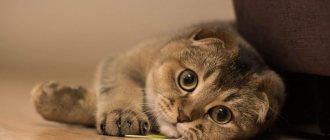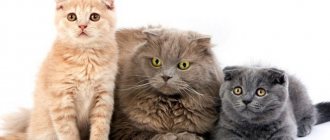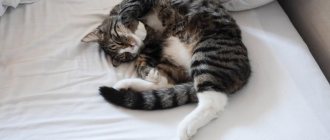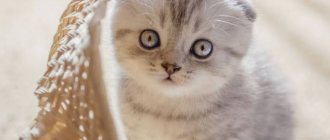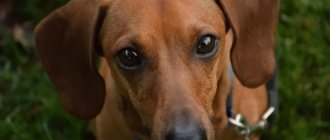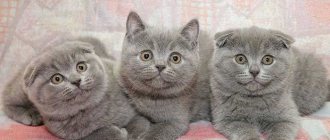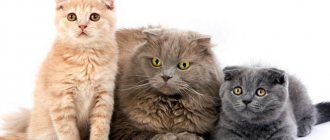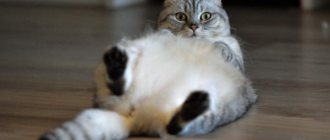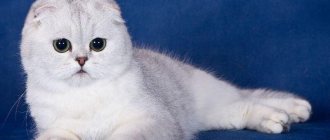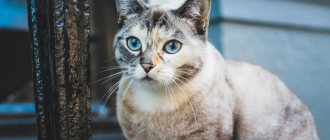Folding ears are associated with the specific structure of the ears. This property was recorded in Scotland in 1961, when breeders began to deliberately breed lop-eared kittens. Hence the second name of this breed – Scottish.
Scientists have discovered that this ear structure is a gene mutation, with lop ears being a dominant gene. When two fold-eared cats are crossed, weak kittens are born. In order for the offspring to be healthy, one parent must have fold ears, and the other must have straight ears. When purchasing, find out which cats your future pet comes from. This will save you from choosing a purebred but sick kitten.
Newborn fold kittens
Kittens in a litter from a fold-eared parent and a straight-eared parent are different, but they can be distinguished from each other after 2-3 weeks.
British and Scottish ears
Important! It is recommended to buy a fold kitten when it is 6 weeks old. At earlier stages, you risk paying a large sum and finding that the kitten's ears will straighten over time.
External signs of lop ears
A fold-eared kitten has structural features of the entire body, and not just the ears. These include:
- The nose is without humps, which can be determined by touch.
- The tail is smooth, without humps or knots.
- Wide muzzle.
- Round head.
- Small cheeks.
- Wide eye set.
- Large chest.
- The legs and tail are shorter and larger than those of their straight-eared counterparts.
- Plush wool.
External signs of fold-eared cats
Interesting! Fold cats are long-haired - Highland Folds, and short-haired - Scottish Folds.
Types of British and Scottish cats
Highland fold
Scottish fold
Nuances
Representatives of the Scottish breed like to sleep in a position unusual for other cats - on their backs. You can also often see a fluffy one standing on its hind legs and carefully examining something. This causes affection not only in children, but also in adults.
There are very few disadvantages in the behavior of a Scot:
- sometimes, due to some selfishness and laziness, it is difficult to accustom a cat to something new, but it is quite possible to fight this;
- It is extremely rare, but it happens that a Scotsman does not get along with a dog . But in case of conflict, the cat will simply go to another place;
- gluttony is a minus of the breed, but you should not feed them - follow the recommendations regarding feeding, about which a little later.
Loss of characteristic: when the ears rise
Straight-eared kittens are called straights, and fold-eared kittens are called folds. The clear difference between them lies in the presence and number of folds on the ears. One fold causes the ears to straighten over time. This does not mean that the kitten is straight. To answer the question about his breed, an examination is carried out. It is especially important for owners who plan to crossbreed kittens. An incorrect conclusion about the straightness of an animal leads to the crossing of two lop-eared individuals and sick offspring. If there are two folds, then it is impossible to predict the outcome: the kitten can remain fold-eared with the same success as become straight-eared. Three folds ensure the ears don't straighten out.
External differences between British and Scottish cats
Folds with erect ears are sterilized to prevent the transmission of a dominant gene that has lost visual expression.
There is a clear sign that distinguishes a fold-eared cat with erect ears from a straight-eared one: the size of the ears. The first one has smaller ones.
Temporary changes in the position of the ears are also possible, the cause of which is weather conditions. The heat causes the Fold's ears to rise slightly.
Important! To purchase fold-eared kittens, choose a time of year with moderate temperatures.
In addition, the ears of the folds also rise in females after giving birth.
Video - Scottish Fold cat
Scots character
Scottish Fold cats are incredibly affectionate and kind. This is the option when a sweet appearance and a gentle character are organically combined. Representatives of the breed easily adapt to a new, hitherto unfamiliar environment (thanks to this, they can often be seen at various exhibitions, because the Scotsman is not a timid cat). By the way, this same character trait makes it possible to take representatives of the Scottish breed with you on trips, as they are easy to transport. Perseverance, calmness and attentiveness also contribute to a cat’s hunting skills.
In addition, they quickly find a common language with other animals and new people. They get along with children absolutely easily and are ready to tolerate some pranks (although the child should still be explained and told how to behave with cats: do not pull the tail and, especially, do not pull the unusual and interesting ears).
This is a cat that likes to live indoors, so it will get along even in a small apartment without any problems, although sometimes it is worth taking it outside.
Adding to the family: how to care for a mother and her newborns
In the first weeks after the birth of kittens, providing proper care is the key to healthy babies and cats. The list of necessary actions on the part of the owners is as follows:
- Provide a warm, dry box for mother and kittens.
- Place a white sheet over it to help track your cat's waste.
- Provide your cat with a balanced diet.
- Organize constant access to water for babies and mothers.
- Do not try to separate the kittens from the cat.
The last point determines the development of the kitten and its viability. If you separate small pets from their parents, you can cause physical harm to them, because the bones are still fragile during this period, deprive the kittens of milk, which is responsible for their immunity, and disrupt their psychological state.
Creating favorable conditions for cats and newborn kittens
Owner reviews
- Oksana. We got a smart kitten - he opens his mouth to take medicine, knows the scratching post and the tray. From infancy he is accustomed to trimming his nails, knows how to follow some commands and is very attached to the child. In general, he is smart, playful, sociable, handsome and not picky. The Scottish Fold is an excellent pet.
- Kate. Our cat is a full-fledged member of the family. When I was little, I never walked and generally stayed away from people. At six months he became more affectionate: he came to be petted and slept next to him, but still on the sidelines. At one year old, he became completely attached to us, but he doesn’t let strangers get close to him. When guests arrive, he tries to hide, and especially does not tolerate children. You can't keep him home all summer. It sleeps in the beds, but if you bring it in from the street, it asks to come back. But, at the first cold weather, he spends all his time with us, loves to chat. We love him with our whole family. I highly recommend the Scottish Fold breed.
- Love. I don't know a simpler and more enjoyable animal to keep at home than the Scottish Fold. Since childhood, our Dusya was indifferent to windows and did not damage furniture or wallpaper. Now she sleeps peacefully at night, and not on our bed, but on her bed. Never hunts for legs. If she sees that the owners are not interested in her, she leaves so as not to irritate her, but will come when necessary. In addition, our cat is in excellent health. I consider my Dusya simply a gift of fate.
The first months of life of Scottish Fold kittens
In the first weeks of life, kittens go through stages from helplessness and huddling around their mother to independent activity and exploration of their environment.
On day 10, their eyes open: they feel more confident and begin to crawl around the cat. After a month, the kittens are fed food that will be their diet throughout their lives. At the same time, they leave the boxes that served them as shelter during the helpless period of life and master the surfaces. This is a favorable period for training a kitten to use a litter tray.
Color genetics
Kittens' eye color gradually changes: from dull blue to their real color. This process takes up to 2 years and is called reblooming. The inclusions appear first, which then spread and provide a permanent color. Green eyes take the longest to form.
What the owner should know
In order for the offspring to be healthy, you need to know some features of mating Scottish Folds:
You need to select a partner of a similar breed, that is, Scottish, but not Scottish Fold. In this case, the best option would be Scottish Straight. This breed of cat has straight ears. If a Scottish straight-eared cat is mated, then the opposite is true, the cat must be fold-eared.
You cannot cross a Scotsman with a British breed. In this case, the cubs are too large, the tail and head are deformed, and the structure of the coat does not meet the standards.
The male must have a uniform color, good quality coat, and a proportional build. You should definitely pay attention to the tail, it must be flexible. This factor affects the health of the animal’s spine. This way, developmental defects in the baby can be avoided.
You should also pay attention to the cat's ears. It would be correct if they are directed forward, small, widely spaced and do not go beyond the head
An important feature is the ear folds, it is very good if they exist. Such breeds are considered unique
It is best if there are two of them, and they are tightly folded on the head. It is very rare to meet a Scot who has three such folds.
It is important to assess the health of the male; he should not have dandruff or any discharge from the eyes, nose or ears. The animal should not be emaciated or too large, everything should be within normal limits.
shutterstock
Many owners of Scottish cats begin to look for a partner through advertisements. This method is not bad; you can select a suitable candidate. But there is another simple way: breeder clubs that specialize in Scottish Folds. The specialists working there will be able to help you choose a suitable male and tell you about his characteristics. By choosing this method of mating, you can be sure of healthy offspring.
Before mating, it is advisable to agree on the amount of the cat’s owner’s fee. He usually gets one baby, which has straight ears. There are always fewer fold-eared kittens; it very rarely happens that all the cubs from one litter are straight. If this is the case, then the cat’s owner receives money as a reward. The amount is equal to the cost of a Scottish Fold kitten.
Before mating, it is advisable to personally make sure that both partners are treated for worms and other parasites. It is permissible to treat the cat before intercourse for diseases such as rabies, chlamydia and other diseases, as well as to prevent worms.
The room where the whole process takes place must be clean, bright, dry and spacious, and it must be warm. The intercourse of animals can last several days, so you need to be prepared for the trip. You need to take with you a tray with filler, bowls for food and water, and the food itself. It happens that a cat is very aggressive, so before mating you need to trim its claws.
Your cat may not get pregnant the first time. In this case, it is necessary to bring her to the cat on the 2-3rd day of the next estrus and leave her there for a couple of days. In one day, a cat can cover a female up to 14 times, but after a few days he ceases to be interested in her.
Constant sleep of newborns - an alarming signal or normal development of the body
Newborn kittens sleep up to 22 hours a day. This is not a cause for concern, because at this time the baby’s nervous system is developing. Sleep contributes to the favorable course of this process. In the first months, the kitten should not be separated from its mother and brothers and sisters. If his weight is normal, it means that development is proceeding normally, and constant sleep is conducive to this.
Newborn kittens sleep up to 22 hours a day
You can familiarize yourself with sleep norms for the initial stages of a kitten’s life in the table.
| Age | Image | Number of hours of sleep |
| Newborn | 22 | |
| 3 weeks | 16 | |
| 1 month | 15-20 |
In order for a kitten to switch to nighttime sleep mode, it should be provided with sufficient activity during the day: play, run. Thus, by night he will be tired, sleep will be necessary to restore strength and will coincide with the biorhythms of the owners.
Description of the breed
Thanks to its touching appearance and positive disposition, the Scottish Fold is one of the most popular breeds all over the world. According to experts, representatives of the breed score the highest points in terms of affection, sociability, level of friendliness and intelligence. There are 4 subspecies of the Scottish Fold breed, differing in the length of their coat and the degree of deformation of the ear cartilage. Other exterior and phenotypic characteristics are similar. The presence of the lop ear gene in a Scottish Fold may mean the presence of hereditary problems with the development of joints and skeletal bones. These characteristics of the breed must be taken into account when caring for pets, minimizing risks in all available ways.
Appearance - what does a Scottish Fold look like?
Today, descriptions of the appearance of the Scottish Fold are used, proposed by various associations (including WCF, CFA TICA, IFA). In terms of basic positions, they are similar. This is a medium-sized cat with a strong build and a softly rounded silhouette.
- The Scottish Fold's head is round in shape and, when viewed from above, domed. The massive lower part is formed by a strong chin, rounded, plump cheeks, and large whisker pads. The frontal part is high and wide, the bridge of the nose is short and straight. The stop line is clearly visible. The nose is small, pigmented in accordance with the color.
- The small ears of the Scottish Fold have a tight fold (or several folds) that gives them a forward and downward direction. The tips are well rounded. The supply of ears is quite wide. The ears should not violate the contours of the head, emphasizing its rounded shape.
- Wide-set eyes – large and round, wide open. Eye color should match the main color.
- The neck is proportional to the body, strong, muscular and short.
- The body of the Scottish Fold is slightly elongated, with a well-developed broad chest. Being of a strong build, the Scottish Fold is not without grace. This distinguishes it from the British type. The legs are medium or short, strong and slender, with small, neat paws.
- The tail is of medium length. Powerful at the base, thinner and rounded towards the tip. A tail that is too thick, immobile and sensitive may indicate a genetic problem. Scottish folds with this feature are disqualified.
Kittens with varying degrees of lop ears are born in the same litter:
- single – the very ends of the ears are bent;
- double – there are two bends of the ear cartilage;
- triple - three bends (the ears are pressed so tightly to the body that it seems like they are completely absent).
All Scottish Fold kittens are born with straight ears. Some kittens from the litter will remain straight-eared (Scottish Straight). How to tell if a kitten is fold-eared or not? The fact is that kittens' ears droop at about three weeks of age. Straight ears are small in size, widely spaced, wide at the base and with sharp tips. The Scottish's ears should always be small enough so as not to disturb the round shape of the head.
Size
The body length of the Scottish Fold from the tip of the nose to the base of the tail is from 50 to 55 cm, with a height at the withers of up to 30 cm. The body length, including the tail, is 75-80 cm.
Weight
The weight of an adult Scottish Fold cat, according to the standard, ranges from 4.8 to 7.1 kg. Thanks to their thinner bones, cats are more graceful. Their weight is 4.5-7.0 kg. Sexual dimorphism is quite pronounced and manifests itself starting from infancy. This can be seen by looking at the Scottish Fold weight table by month.
Kitten weight by month (table):
| Age | Scottish Fold cat (kg) | Scottish fold cat (kg) |
| 1 month | 0.35 — 0.6 | 0.4 — 0.7 |
| 2 | 0.45 — 0.75 | 0.8 — 1.6 |
| 3 | 1.2-1.65 | 1.35 — 2.45 |
| 4 | 1.7 — 2.3 | 2.1 — 3.8 |
| 5 | 2.2 — 3.2 | 2.4 — 4.2 |
| 6 | 2.3 — 3.6 | 2.9 — 5.56 |
| 8 | 2.8 — 4.3 | 3.45 — 6.2 |
| 10 | 3 — 4.64 | 4.2 — 7.2 |
| 12 | 3.2 — 5.4 | 4.6 — 7.4 |
| 24 | 3.44 — 5.6 | 5.4 — 8.2 |
Scottish Folds reach adult weight at 2 years of age, when puberty begins.
Wool
Depending on the length of the coat, two subspecies of the Scottish Fold breed are distinguished.
- Scottish Fold (shorthair) - cats with two-part, thick hair. The outer hair is short and soft, giving a plush feeling to the touch. Thanks to the thick, downy undercoat, the outer hairs are vertical. As a result, the shorthair cat is quite fluffy.
- Highland Fold (long-haired) has wool up to 5 cm long. The outer coat has a soft, silky structure and, thanks to the thick undercoat, does not adhere tightly to the body.
The texture of the coat of both longhaired and shorthaired varieties varies depending on the season, color type, climate and lifestyle.
Colors
A distinctive feature of Scottish Fold cats is their extraordinary variety of colors. The standard imposes certain requirements regarding the combination of coat color with the shade of the iris, nose and paw pads. Violation of this combination will result in a reduction in the qualifying mark at the exhibition.
- Black color. Pure black color of the coat and nose is allowed, without the presence of any colored spots. The black Scottish Fold's eyes are golden or dark honey.
- The white Scottish Fold has a snow-white coat, without spots or colored inclusions. A brightly colored iris is welcome. Acceptable colors are blue, orange, amber, copper. White Scottish Folds may have heterochromia.
- Blue or gray color. Blue Scottish Fold wool should be brightly and uniformly colored. The color of the iris is yellowish or copper.
- Red or tan coloring is rare in Scottish Folds. Individuals with tail stripes will be disqualified.
- Cream or peach color is very valuable. A striped pattern on the paws or tail is possible.
- Purple fur (aka café au lait) should be combined with yellow or amber eyes. The nose is beige or light brown.
- Fawn is a smoky fawn color with a chocolate tint. The nose and paw pads are light pink.
- Chocolate is a rare and beautiful color. Adult Scottish Folds are characterized by dark chocolate shades.
- Cinnamon is a rare and expensive color. It is cinnamon with the addition of cocoa. The nose and paw pads of Scottish Folds should be bright pink with a brownish tint.
- Scottish Folds are bicolor with a white base color. The paws, muzzle, collar, chest and belly are painted in it. The paired color can be any. Eyes – amber or honey.
- Paticolor combines white and tortoiseshell or white and tabby or tabby-brown (tri-color coat).
- Elegant harlequin – black and white. This Scottish Fold has a white body combined with black paws, tail and head area. The nose is pink.
- The Van color is known for its colored tail and several colored spots on the head. Red van (red or copper spots) is more valuable than others.
- Colorpoints have colored tan markings. Possible shades of wool are chocolate, cream, red, blue, lilac. The color point color, where the main color is white, is especially valued among Scottish Folds. The eyes must be bright blue.
- The ticked color is formed by zonally dyed wool. There are options: red, blue, black, silver. The color of the iris is amber, yellow, copper, green.
- Tabby is a striped color. Marble or tiger varieties are possible.
- Chinchillas are not a natural, but an artificially bred color. Scottish Folds have tortoiseshell, bicolor, and smoky colors. The peculiarity of the color is a light or white undercoat, a dark mask on the muzzle in the form of a dark border around the eyes, nose and lips. When coloring a chinchilla, a hazel tint to the eyes is not acceptable.
Periodization of the kitten's life stages. The first stage - mom is nearby
Kittens grow up to 1 year, during which significant changes occur every month. At the same time, 2-2.5 years is the period when the body finally gets stronger and becomes an adult.
| Age | Image | Peculiarities | Recommendations |
| First week | Weight – 100 g. Body length – 9-12 cm. No hearing until the 4th day. Eyes don't open. Undercoat appears. The umbilical cord separates on the 3rd day | Food is mother's milk, which the baby senses through olfactory receptors and consumes naturally. Antibodies contained in cat milk help an unvaccinated kitten resist infections. Do not disturb the unity of the kitten and the cat, so as not to scare the baby | |
| Second week | Weight - 250 g. By the end of this period, the eyes open; at first, the eye color of all kittens is cloudy blue. Attempts to walk, crawl away from the mother by 30-50 cm. | Stroke the kitten gently. Do not cause aggression on the part of the mother cat, who is worried about the younger generation at their first manifestations of independence | |
| Third week | Weight – 300 – 350 g. Support on 4 legs. On days 15-17 they begin to see. Orientation in distances. First milk teeth. Scratching behind the ear. Interest in playing with people | Play with kittens without sudden movements. Do not leave small children and kittens unattended | |
| Fourth week | Weight – 450 g. Approximately 26 teeth | Organize worm prevention. Drink filtered water from shallow bowls. Provide the kitten with constant access to water | |
| Fifth week | The cat reduces the level of care for the baby. The kitten learns to wash itself. The fur becomes brightly colored | Stock up on age-appropriate liquid food. Include solid foods in your diet. Provide the kitten with constant access to food (100 grams of food is the norm). Do not allow your baby to eat from adult bowls. Organize a pet house |
How to choose a kitten
You should not buy a fold-eared kitten under 2.5 months. By this age, the ears have already formed, the kids have acquired the necessary skills and are ready to move.
Kennels breed Scottish Folds. You should not buy mixed breeds - health and character can be unpredictable. You will only become attached to your pet when serious chronic problems are discovered. Purebred Scots have all the positive qualities of the breed.
The main problem for Scots is joint dysplasia (JD). This is a serious disease of the joints and spine. By buying a cat from a trusted breeder, you protect yourself and the animal from problems. However, the American Cat Fanciers Association CFA advises to always check a kitten when purchasing:
- Determine the flexibility of the tail. To do this, very quickly move along it with a light, slightly curving movement towards the end. There is no need to bend or break the cat's tail.
- Check the paws, they should bend at all joints.
- Watch how the kitten moves. There should be no hint that unnaturally short, stiff legs interfere with his walking.
Pay attention to active kittens. Ask about the age of the mother - mating in cats is allowed only after the fourth heat. Look at the kitten vaccination passport: at this age it should already be carried out.
Over time, the color and eyes will become brighter. The coat may be slightly paler than the mother's, but it should be evenly colored.
The cost of a Scottish fold kitten starts from 10,000 rubles and depends on whether you need a show breed or show-class cat or just a pet.
The second stage is independence and growing up
| Age | Image | Peculiarities | Recommendations |
| Sixth week | The final transition from mother's milk to foreign food | Feed the kitten 6 times a day, 40 grams of food at each meal. Observe the animal's stool; if there are any problems, contact a veterinarian after 3 days. | |
| Seventh week | Weight – 550-900 g. Males stand out among females in size | The kitten should not drink its mother's milk. Balance of dry and liquid food | |
| Eighth week | Weight – 750 – 1200 g. All milk teeth. Eats solid food | Separate from mother. Get examined by a veterinarian. Monitor the condition of your ears and eyes. Comb | |
| Ninth week | Forming a type of relationship with the owners | Get vaccinated | |
| Tenth week | Weight – 850-1400 g. Independence. Sensitivity to learning | Do not be aggressive in training | |
| Eleventh week | Research stage: exploring the corners of the apartment | Prevent the kitten from colliding with dangerous objects: close windows, remove small parts, toxic substances | |
| Twelfth week | Weight – 900-1600 g. Change of eyes Pet’s response to its name, to the call for food | Organize repeated prophylaxis against worms. Stop kitten aggression | |
| Thirteenth - fifteenth weeks | Weight – 1.5 kg. Molars appear | Feed 5 times a day. Trim nails regularly | |
| Sixteenth week | Weight – 1.8 kg | Get vaccinated | |
| Five months | Weight – 2 kg | Feed 4 times a day. Get a rabies vaccination | |
| Six months | Strong molars. Dimensions of an adult animal. Puberty | Organize worm prevention. Feed 3 times a day. Sterilize if there is no goal to breed offspring | |
| Seven months | Seasonal molt | Brushing your pet | |
| Eight – nine months | The cat is almost an adult | Sterilize if not done before. Consult your doctor about vaccination | |
| Ten – eleven months | Adult phase of life | Include food for adult cats in the diet |
Cat vaccination periods
Important! When the cat turns one year old, his diet should consist only of food for adults, and meals should be reduced to 2 per day.
Nutrition
When choosing food, do not skimp and choose products of at least super-premium class, this way you will protect your pet from stomach diseases.
If you feed your cat natural products, you will have to fork out for fish, lean meat, cheese and various dairy products. It will only be whites.
The animal can get carbohydrates from bread, various cereals and potatoes, and fats from egg yolks and vegetable oil. With such feeding, it is necessary to add vitamin-mineral complexes to the food.
Determining the age of a fold-eared kitten
| Way | Sign | Age |
| External signs | Umbilical cord | A few days |
| Open eyes | At least a week | |
| Open ear canals | 5-8 days | |
| Erupting incisors | 2-3 weeks | |
| The eyes have opened, but not completely yet | 2-3 weeks | |
| Milk fangs | 3-4 weeks | |
| Changing eye color | 6-7 weeks | |
| All baby teeth | 4 months | |
| All molars | 7 months | |
| Behavioral signs | The kitten starts to walk | 2-3 weeks |
| The kitten can roll over in the air | 3-4 weeks | |
| Responsive to outside noise | 3.5 weeks | |
| Kitten running | 5 weeks | |
| The cat does not feed the kitten | 7 weeks | |
| Signs of puberty | Loud meowing, attempts to run away from home | 4 months |
| Males mark territory | 4 months | |
| First heat in females | 4-6 months | |
| Attacking other kittens to establish dominance | 7 months |
Characteristics of the Scottish Fold cat breed
Important! At 7-8 months, the kitten should pay special attention, since it is at this time that it socializes and gets used to the company of people.
Health
Scottish Folds suffer from a large number of genetic diseases, which is why they often suffer from serious incurable diseases. Healthy pets are very hardy and have strong immunity.
Calicos, tortoiseshells
It is known that predominantly cats are born this way, and a male tri-colored individual is a rare occurrence and without the possibility of procreation. Tortoiseshell Scottish Folds are distinguished by alternating red and black spots.
Color variations are possible, for example, lightening, then areas of the coat will be blue and cream. Breeders strive to produce “turtles” with uniform coloring and a symmetrical arrangement of spots.
Calicos are rare among Scottish Folds, but the cats look very impressive. They are recognized by their white background and colored spots. There may also be bright colors and weakened ones. Diluted Calico - there is much more white base.
Eye color depends on the base color and the distribution of spots on the head and face. In any case, a bright and shining color is welcome.
Calico cats are prized for their diversity of offspring. The name of the color in translation is “patchwork”, which fully describes the appearance of the animal.
Conditions of detention
Scottish cats are considered one of the easiest pets to care for. They feel great both in a small apartment and in a private house. It is worth buying or making your own personal sleeping place for an animal. It is also recommended to purchase a scratching post, the length of which should correspond to the height of the Scottish cat. You should not refuse to buy a carrier to transport your pet if necessary.
The Scots are not picky when it comes to content. In order for an animal to live comfortably in a room, it must be clean and safe. This pet is extremely clean, he puts his fur in order and quickly gets used to going to the litter box.
Before bringing a small pet into your home, you need to complete the following steps.
- Remove unnecessary objects from the kitten's access area. For example, wires, breakable and sharp objects.
- Buy food and water dishes for the animal. The best option would be heavy metal or ceramic cookware.
- Place the tray and fill it with filler. Kittens should buy a container with low sides, and as they grow older, change it to a higher model.
- Prepare a place to rest - this can be a sunbed or a blanket folded several times.
- Buy food, toys, scratching post.
Grooming
Scottish cats can be shorthaired or semi-longhaired. With cats that have short hair, there is little hassle. Their fur is brushed weekly using a special mitten or a brush with natural bristles. Semi-long-haired representatives of the breed should purchase a comb that has Teflon-coated teeth. Animals should be taught to comb from a young age.
Animals kept in the house are bathed monthly. Scots usually react well to water, but they should only wash their coat if it gets dirty. For this procedure you need to buy a special shampoo for cats. When bathing your pet, you need to make sure that water does not get into his ears. After washing, the cats are dried and sent to a warm place where there is no draft.
For water procedures, preference is given to colorless and odorless shampoos that do not contain harmful chemical ingredients and allergens. Scottish cats that participate in exhibitions are bathed depending on the color of their coat. Dark animals need to be washed a week before the event, and light animals - 5 days.
Haircuts for Scottish cats are unpleasant, but common procedures. Pets are given haircuts and hairstyles for the same purpose as other animals. This procedure can be carried out only if tangles have formed, as well as after applying medications or to remove dirt.
Nail care
Domestic cats need their nails trimmed. This process is quite simple and does not cause discomfort to the animal. You need to put Scottish on your lap and, taking his paw in your hands, press on the pads. Once your pet has released its claws, they can be trimmed. In this process, the main thing is not to damage the living body of the claw. Claws should be trimmed carefully, once every 2-3 weeks.
Eye and ear hygiene
The eyes and ears of Scottish cats need regular examination. These animals usually have clean ears, but when plaque appears in them, the contamination is removed with a cotton swab. When cleaning your ears, you can also use a special lotion.
The special structure of the skull of the Scottish breed of cats causes the narrowing of their nasolacrimal ducts. For this reason, your pet may experience slight discharge from the eyes. In this case, the eyes need to be cleaned with a cotton pad or chlorhexidine wipe.
Dental care
To keep the pet's teeth in good condition, the owner can buy him a special toy - an edible chewing stick. Alternatively, you can use a toothbrush and toothpaste for cats. A Scottish cat's teeth should be brushed 1 or 2 times a week. Scottish dogs do not like this process, so it is better to accustom them to this from an early age.
Kitten care
Scottish kittens do not require special care. They can be fed dry food, but of good quality. Kittens should not be brushed unless there is a reason for it. Babies with long hair should be gradually accustomed to brushing, carrying out the procedure twice a month. Little Scottish cats need to be bathed only if they are very dirty in the mud.
Kittens need to have their nails trimmed from an early age so that they get used to this procedure. You don't need to clean your ears, but if they smell bad, that's a reason to go to the vet. Watery eyes should be wiped once every 7 days with a cotton pad soaked in chlorhexidine.
Standard Scottish Fold colors
Most felinological organizations allow the following types of colors:
- Solid - a solid background without a pattern;
- Tabby - the pattern is expressed on any background;
- Spotted - spots of different colors on the main white;
- Calico, tortoiseshell - alternating white, black, red spots;
- Lightened and shaded - blue, cream, lilac, chinchilla;
- Color point – light body fur, darker paws, tail, mask on the face.
Important: The CFA standard excludes the following colors of Scottish Folds: color point and all lightened ones, classifying them as consequences of crossbreeding with other breeds.
It is difficult to find out what the real color of the ancestor of the Scottish Fold, Susie, is. Cats and cats have two genetic colors - red (red) and black.
White can be compared to a cape or cloak; underneath it hides the true color. Blue, chocolate, lilac are variations of black, and cream is red, like calico. Therefore, when mating with a white fold cat, they look at the colors of the closest relatives (parents, grandparents).
The colors are described in detail in the standards. However, a lot of attention is paid to physique during assessment.
